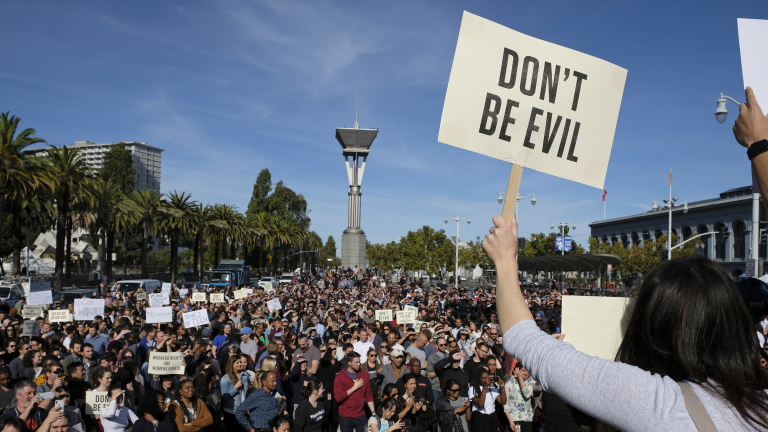Trump baby blimp back and could be even bigger for UK state visit
Balloon depicting nappy-wearing US president could be five times size of predecessor
Matthew Weaver
Tue 23 Apr 2019

The baby blimp during a women’s march to Parliament Squar in London last July. Photograph: Andrew Aitchison/In Pictures/Getty
The Donald Trump baby blimp, which became the focal point of protests against the US president’s visit to the UK in July, will rise again for the state visit and could be accompanied by a bigger version, activists have revealed.

What happened next? The Trump baby blimp: 'In retrospect, we should have ordered a bigger balloon'
Anti-Trump campaigners are considering launching a hot air balloon, five times the size of the blimp, which would also depict Trump as a wailing baby in a nappy.
Leo Murray, who helped crowdfund the original six-metre-high inflatable, said: “The Trump baby will definitely fly again.”
He added: “We have been toying with the idea of a Trump baby hot air balloon, which would be about five times the size. But would cost a huge amount of money – upwards of £70,000.”
The shadow Treasury minister, Clive Lewis, called on protesters to “dust off the blimp” amid widespread opposition to the three-day state visit in the first week of June, announced on Tuesday.
Last year, the London mayor gave permission for the Trump blimp to fly over the capital in a move that infuriated the president’s supporters.
A spokesman for Sadiq Khan hinted that an attempt to relaunch the balloon would be approved. He said: “Any application to fly it on land that the Greater London Authority manages will be judged by the same criteria as last time by GLA officials, the police and the Civil Aviation Authority.”
But campaigners fear the authorities will block the approval for a bigger version of the blimp. Asad Rehman, the executive director of War on Want and a member of the Stop Trump Coalition, said: “We do have the baby blimp – it will fly and we’re also thinking about the option of making a bigger baby blimp. Logistics are the only consideration.”
He added: “We are very confident there will be more than a quarter of a million protesters. Trump’s visit last year mobilised a large number of people, but a year later the man has done more to rip up human rights, step back from international norms, continued his climate denialism and fuelled white nationalism.”
Murray conceded that raising money for the bigger blimp “might not be the best use of resources, especially if we are unable to fly it over London”.
Military Traverse Underneath Alcatraz
BY STEPHANIE VALERA 03.01.2019

Aerial photograph (dated 1930s) of the Alcatraz island and penitentiary in the San Francisco Bay. (Photo Credit: OFF / AFP / Getty Images)
Alcatraz holds many forgotten secrets, but one has been discovered: High-tech radar and laser scans have uncovered a hidden military traverse underneath the infamous penitentiary, according to new research.
A team of researchers from Binghamton University, State University of New York used terrestrial laser scans, ground-penetrating radar data, and georectifications (the process of taking old digitized maps and linking them to a coordinate system so that they can be accurately geolocated in 3D space) to locate and assess the historical remains beneath the former recreation yard of the Alcatraz penitentiary, according to a press release.
The scans revealed that remnants of buried structures, including a “bombproof” earthwork traverse along with its underlying vaulted brick masonry tunnel and ventilation ducts, ran east to west beneath the recreation yard of the Alcatraz penitentiary, which is located in the San Francisco Bay, 1.25 miles offshore from San Francisco, Calif.
Binghamton University archaeologist Timothy de Smet, whose team’s findings are detailed in a paper published in the journal Near Surface Geophysics, said he was shocked to discover that the historical structures were maintained in such good condition.
“The remains of these historical archaeology features were just a few centimeters beneath the surface and they were miraculously and impeccably preserved,” de Smet said. “The concrete veneer of the Recreation Yard floor is incredibly thin and, in fact, in places sitting directly atop the architecture from the 1860s. We also learned that some of the earthwork traverses were covered over with thin concrete layers through time, likely to decrease erosion on the rainy windy island.”
Known as a former high-security federal penitentiary that once housed many of America’s most notorious gangsters and criminals, such as Al Capone, Alcatraz Island is now a National Historic Landmark that attracts several tourists in its location adjacent to the Golden Gate Bridge.
However, many overlook Alcatraz’s former military role as a 19th century coastal fortification, featuring underground ammunition. Since it was converted to a prison, researchers have been interested to see if there were any historical remains left of the fortification.

Binghamton University archaeologist Timothy de Smet and colleagues used terrestrial laser scans, ground-penetrating radar data and georectifications to locate and assess historical remains beneath the Alcatraz Federal Penitentiary. (Photo Credit: Timothy de Smet)
According to de Smet, during the construction of the Alcatraz prison in the 1900s, the area was essentially bulldozed from the former military installation to the modern prison we see today.
“We sought non-invasive, non-destructive means to ascertain if any historic archaeological remains lay beneath several parts of the island, like the Recreation Yard of the infamous US Federal penitentiary,” said de Smet. “We did not know what to expect. We did not know if there would be any extant subsurface architecture of these historically significant remains, or if there was anything left, what their extent and integrity would be like.”
The noninvasive process used by researchers permits accurate spatial identification 19th-century architectural structures depicted in historical documents. And this groundbreaking approach can also be applied to investigate other important cultural landmarks worldwide.
de Smet said the results prove that archaeologists can detect historical structures in a gentler manner: “These results are significant in that they show how modern technology can be used to answer fundamental questions of archaeological importance without any destructive excavations. This research shows that best practice approaches can be used to non-invasively non-destructively investigate the archaeological record with remote sensing alone.”
'It's clear we won': Istanbul's new mayor keen to start work
Ekrem İmamoğlu delivered a shock to the president but the fight for control of the city is not over

Bethan McKernan and Gokce Saracoglu in Istanbul
Mon 22 Apr 2019

Ekrem İmamoğlu was an outsider pick as the opposition coalition’s candidate for mayor of Istanbul. Photograph: Anadolu Agency/Getty Images
Thousands of people gathered in Istanbul’s seaside Maltepe district on Sunday to see a politician take the stage in dazzling spring sunshine, red Turkish flags fluttering in the wind.
Such scenes are normal in Recep Tayyip Erdoğan’s Turkey, but this rally wasn’t for him. It was for Istanbul’s new mayor, Ekrem İmamoğlu, who last month delivered one of the biggest challenges to Erdoğan’s grip on the country in years.
Local elections on 31 March proved to be an unexpected watershed momentin Turkish politics, as usually run-of-the-mill races for mayors and neighbourhood administrators became a referendum on Erdoğan’s handling of the faltering economy.
The ruling Justice and Development party (AKP) and an allied nationalist party won more than half of the votes across Turkey as a whole. But despite almost blanket pro-government media coverage, they lost Istanbul, the country’s economic and cultural powerhouse, as well as the capital, Ankara, breaking Islamist parties’ control of the two cities for the first time in a quarter of a century.
The AKP has challenged the secular Republican People’s party’s (CHP) win in Istanbul. As Erdoğan’s home town and the place where his political career took off as mayor in the 1990s, the city was a particularly painful loss for the president. His party has alleged ballot box fraud and asked Turkey’s electoral board for a rerun.
With a decision pending and possible new elections proposed for 2 June, the fight for control of the city is not over. But İmamoğlu seemed unperturbed as he settled into his new city hall office during an interview with the Guardian last week, wandering around the grand room to straighten gilt-framed pictures hanging on the walls.
“I am not feeling any pressure,” the 49-year-old said. “There are 16 million people in this city waiting for me to serve them and do the job I was elected to do. We need to work together and we can walk this road to success.”
İmamoğlu’s inclusive and conciliatory rhetoric was a large part of what got him elected: he strikes a tone very different to that of the firebrand politicians who have come to dominate Turkey’s polarised political scene. During the mayoral campaign, İmamoğlu reached out to working-class and pious AKP voters usually alienated by the middle-class CHP and talked about the need to integrate Syrian refugees into Turkish society.
“Lots of AKP voters asked me why I wasn’t running for their party instead,” he said. “They were pleased when I asked for their prayers rather than their votes.
“I don’t believe the public accepts divisive rhetoric and discriminatory policies. Populism has the upper hand in the world at the moment, but it will end eventually. Treating people with respect always wins out.”

İmamoğlu addresses supporters during a rally in Istanbul on Sunday. Photograph: Emrah Gürel/AP
İmamoğlu was an outsider pick as the opposition coalition’s candidate for mayor of Istanbul. He entered local politics in 2009 in an effort to sort out red tape facing his family construction business, eventually becoming mayor of the middle-class Beylikdüzü district in 2014’s local elections – the only seat gained by the CHP in the city that year.
Although well liked by constituents in Beylikdüzü, he was unknown to voters in the rest of Istanbul when he was pitted against the former prime minister Binali Yıldırım, a candidate hand-picked by Erdoğan to ensure an AKP victory, in last month’s election.
On election night as the initial results started to indicate a surprise CHP win, İmamoğlu held his ground, refusing to concede despite a premature victory announcement from Yıldırım.
“I didn’t sleep for almost 48 hours and I think we held 13 press conferences in the 24 hours after polling stations closed,” he said. “The official state agency was giving misleading numbers we knew were wrong. People were getting anxious and it was very stressful but we had to be sure we were right before we made a challenge.”
Canan Kaftancıoğlu, the CHP chair for Istanbul, said: “We were very prepared for the elections this time. We did our own polling, we had a double checking system to count votes, we made sure ballot boxes could not be tampered with. As the opposition we have finally learned from our previous mistakes in dealing with the government.”
Istanbul’s unofficial result - the final count still has not been verified – sent shockwaves through the rest of Turkey. İmamoğlu’s victory puts him at the forefront of resurgent social democratic movements around the world. But although he is now being touted as a potential candidate to run against Erdoğan for president in 2023, İmamoğlu said he did not see himself as a figure on the world stage.
“I think that judgment should be made by others, not by me. My decisions and my path in politics are a result of the fact that I’m a good manager with 10 years’ experience in getting things done,” he said.
There are potentially many obstacles in his path. Selahattin Demirtaş, another figure once touted as the Turkish opposition’s hope for the future, is in prison on charges related to the militant Kurdistan Workers’ party (PKK), which he denies. Despite a strong campaign, Muharrem İnce, the CHP presidential candidate in 2018, quickly folded without explanation on election night.
İmamoğlu reached out to Erdoğan at the beginning of the local election campaigning, meeting him in Ankara, but the president delivered a pointed snub at an official engagement in Istanbul last week, refusing to shake his hand.
İmamoğlu, for his part, would risk the government’s anger if the CHP boycotts a rerun in Istanbul. Several CHP sources told the Guardian the party would refuse to engage in any AKP attempts to change last month’s result.
“I’m not even entertaining the thought of a rerun,” İmamoğlu said. “It’s clear we won. [The AKP] want to make people think otherwise, but it’s over. It’s time to move on.”
Seventeen days after the election, İmamoğlu’s team was finally given access to city hall on Wednesday night. The hectic activity in the building came to a brief standstill on Friday afternoon as İmamoğlu made his first address to municipality workers.
“I don’t want to be worshipped or feared. I just want you to work alongside me so we can do the best possible job for the people who elected us,” the new mayor told several hundred employees, some of whom leaned over balconies and took out phones to film the speech. “We have a lot of work to do.”
Ethical Tech
A Googler who brought down Google’s AI ethics board says she’s now facing retaliation

One of the leading figures in the movement to disband Google’s AI ethics board says she and other employee activists are now being punished for their activism.
In an e-mail circulated internally within Google and obtained by Wired, Meredith Whittaker, who leads Google’s Open Research and cofounded the research institute AI Now, wrote that after the ethics board’s dissolution, she was informed that her role would be “changed dramatically.” “I’m told that to remain at the company I will have to abandon my work on AI ethics and the AI Now Institute,” she said.
Since its founding, AI Now has become an influential cornerstone of research on AI ethics and social impact, releasing reports and hosting annual summits that have sparked vigorous debate within the rest of the field. “Meredith [...] has been a real pioneer & thought leader on AI ethics, especially when it comes to ML bias, diversity, & inclusion,” François Chollet, a leading deep-learning expert at Google, wrote on Twitter. “I believe that her work is critical to Google’s mission, as an AI-first company [and...] I hope that she will be able to carry on her important work.”
In a statement, a Google spokesperson denied the allegations: “Employees and teams are regularly and commonly given new assignments, or reorganized, to keep pace with evolving business needs. There has been no retaliation here.”








